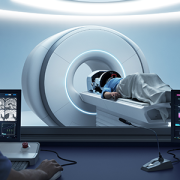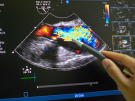Brain tumor team performs first ever LIFU procedure on pediatric DIPG patient

The ultrasound waves activate the drug selectively within the tumor, causing tumor cell death. Credit: Image provided by Insightec.
A multidisciplinary brain tumor team at Children’s National Hospital successfully performed the first treatment with sonodynamic therapy utilizing low intensity focused ultrasound (LIFU) and 5-aminolevulinic acid (5-ALA) medication on a pediatric patient. The treatment, performed on a 5-year-old child diagnosed with a diffuse intrinsic pontine glioma (DIPG), was done noninvasively through an intact skull. The child was discharged from the hospital one day later.
What happened?
Shortly after announcing the use of LIFU, the brain tumor team at Children’s National treated the patient as part of a cutting-edge trial using LIFU combined with a novel medication.
The ultrasound waves – which are given while the child is asleep through an intact skull and does not require an invasive neurosurgical procedure – activate the drug selectively within the tumor, causing tumor cell death.
“This treatment is currently being trialed in adults diagnosed with recurrent glioblastoma tumors, but has never been attempted in pediatric patients,” said Hasan Syed, M.D., co-director of the Focused Ultrasound Program at Children’s National. “Similar to the adult trial, our protocol involves using a medication that is taken up by tumor cells and then targeting those cells with LIFU to induce tumor cell death, and hopefully leading to tumor control.”
Dr. Syed co-directs the program with Roger Packer, M.D., head of the Brain Tumor Institute, and Lindsay Kilburn, M.D., director of the Experimental Therapeutics Program.
How are we leading the way?
The launch and use of LIFU was possible thanks to the efforts of a multidisciplinary team from various departments that understood if too high a dose of ultrasound was utilized, there could be associated brain swelling and even death.
“Our efforts show great teamwork and a commitment from the hospital and our clinical teams to develop innovative means to treat a tumor that kills 90% of those children afflicted within 18 months of diagnosis,” Dr. Syed said.
The work shows expertise of the brain tumor team, as well as radiology, anesthesiology and intensive care units.
“Despite the risks involved, the use of focused ultrasound is a novel way to try to treat these very deep-seated lesions that have been highly resistant to all forms of therapy and is potentially the greatest breakthrough we’ve had in this disease in the past 50 years,” Dr. Packer said.
What has limited therapy in the past?
DIPGs are deep-seated in critical areas of brain, controlling breathing and heart rate and cannot be removed. The brain has an intrinsic system called a blood brain barrier which blocks drugs from getting to the tumor.
Focused ultrasound is a new way to overcome the brain’s ability to stop the drugs from getting there. It can also be used to activate a drug as it passes through the brain stem.
“We are extremely excited to have taken the first step in developing this novel and non-invasive approach to treating one of our most deadly brain tumors,” Dr. Kilburn said. “This is the first step of numerous steps toward evaluating the many potential uses of LIFU as part of combination therapies to treat children with DIPGs and eventually other pediatric brain tumors.”
Children’s National is partnering with other institutions across the world to perform these studies. But because of the commitment of its team and its expertise, it is the first to use this technique in a child.
“I think we’re in a unique position thanks to the collaborations possible at Children’s National and the expertise of those caring for children with brain tumors,” Dr. Packer added.
Why we’re excited
The Brain Tumor Institute at Children’s National is excited about making this a potential treatment option for DIPG patients, which currently have really no surgical options or alternatives. It’s a way to deliver the ultrasound and therapies in a potentially less toxic way, not requiring surgery.
This trial and subsequently others will give doctors more options for children with DIPGs and other malignant tumors.











